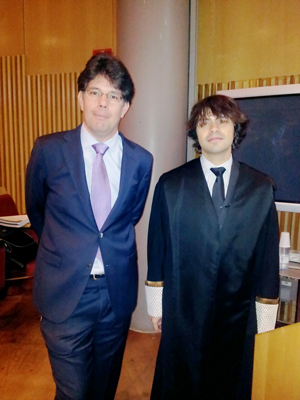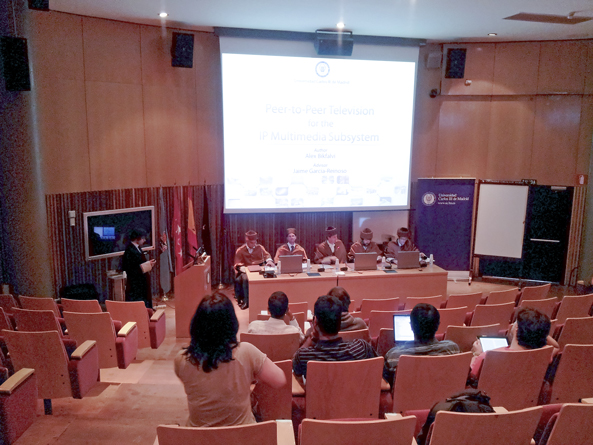Universidad Carlos III de Madrid, Avda. Universidad, 30, 28911 Leganés – Madrid
Abstract:
 Peer-to-peer (P2P) video streaming has generated a significant amount of interest in both the research community and the industry, which find it a cost-effective solution to the user scalability problem. However, despite the success of Internet-based applications, the adoption has been limited for commercial services, such as Internet Protocol Television (IPTV). With the advent of the next-generation-networks (NGN) based on the IP Multimedia Subsystem (IMS), advocating for an open and inter-operable architecture, P2P emerges as a possible alternative in situations where the traditional mechanisms are not possible or economically feasible.
Peer-to-peer (P2P) video streaming has generated a significant amount of interest in both the research community and the industry, which find it a cost-effective solution to the user scalability problem. However, despite the success of Internet-based applications, the adoption has been limited for commercial services, such as Internet Protocol Television (IPTV). With the advent of the next-generation-networks (NGN) based on the IP Multimedia Subsystem (IMS), advocating for an open and inter-operable architecture, P2P emerges as a possible alternative in situations where the traditional mechanisms are not possible or economically feasible.
This work proposes a P2P IPTV architecture for an IMS-based NGN, called P2PTV, which allows one or more service providers to use a common P2P infrastructure for streaming the TV channels to their subscribers. Instead of using servers, we rely on the uploading capabilities of the user equipments, like set-top boxes, located at the customers’ premise. We comply with the existing IMS and IPTV standards from the 3rd Generation Partnership Project (3GPP) and the Telecommunications and Internet converged Services and Protocols for Advanced Networking (TISPAN) bodies, where a centralized P2PTV application server (AS) manages the customer access to the service and the peer participation.
Because watching TV is a complex and demanding user activity, we face two significant challenges. The first is to accommodate the mandatory IMS signaling, which reserves in the network the necessary QoS resources during every channel change, establishing a multimedia session between communicating peers. The second is represented by the streaming interruptions, or churn, when the uploading peer turns off or changes its current TV channel.
To tackle these problems, we propose two enhancements. A fast signaling method, which uses inactive uploading sessions with reserved but unused QoS, to improve the tuning delay for new channel users. At every moment, the AS uses a feedback based algorithm to compute the number of necessary sessions that accommodates well the demand, while preventing the over-reservation of resources. We approach with special care mobility situations, where a proactive transfer of the multimedia session context using the IEEE 802.21 standard offers the best alternative to current methods.
The second enhancement addresses the peer churn during channel changes. With every TV channel divided into a number of streams, we enable peers to download and upload streams different from their current channel, increasing the stability of their participation. Unlike similar work, we benefit from our estimation of the user demand and propose a decentralized method for a balanced assignment of peer bandwidth.
We evaluate the performance of the P2PTV through modeling and large-scale computer simulations. A simpler experimental setting, with pure P2P streaming, indicates the improvements over the delay and peer churn. In complex scenarios, such as those with resource-poor peers having a limited upload capacity, we envision P2P as a complementary solution to traditional approaches like IP multicast. Reserving P2P for unpopular TV channels exploits the peer capacity and prevents the necessity of a large number of sparsely used multicast trees. Future work may refine the AS algorithms, address different experimental scenarios, and extend the lessons learned to non-IMS networks.
Who is Alex Bikfalvi?
 I am a doctoral student under the supervision of professor Jaime García-Reinoso at the Telematics Engineering Department from the Carlos III University (UC3M), in Leganés, Madrid, Spain. I received a Master of Science degree in telematic engineering from the Carlos III University in 2008 and an Engineering degree in electrical engineering (telecommunications) from the Faculty of Electronics, Telecommunications and Information Technology at the Technical University (UTCN) of Cluj-Napoca, Romania in 2006.
I am a doctoral student under the supervision of professor Jaime García-Reinoso at the Telematics Engineering Department from the Carlos III University (UC3M), in Leganés, Madrid, Spain. I received a Master of Science degree in telematic engineering from the Carlos III University in 2008 and an Engineering degree in electrical engineering (telecommunications) from the Faculty of Electronics, Telecommunications and Information Technology at the Technical University (UTCN) of Cluj-Napoca, Romania in 2006.
My current research interests include peer-to-peer overlays, content distribution such as video-streaming (IPTV, video-on-demand) in the Internet and Next Generation Networks. I worked also on distributed resource discovery, quality of service and network measurements. I like software development and I have experience with many programming languages.
Previously, I was a research assistant at the Madrid Institute for Advanced Studies in Networks, where I participated on several research projects including the CONTENT Network of Excellence, funded by the European Union under the VIth Framework Program, and BioGridNet, funded by regional government of the Autonomous Community of Madrid.
Before joining the UC3M and the Institute IMDEA Networks, I worked as a software engineer for the professional services division of Alcatel-Lucent in Romania and Australia. My experience there includes large billing systems, software integration and testing (performance, functional and regression). I am familiar with tools like IBM Netcool for network management, Business Objects for business intelligence, HP LoadRunner, QuickTest Professional and Quality Center for testing.


Autor: Alex Bikfalvi, Estudiante de Doctorado, Institute IMDEA Networks
Director de tesis: Dr.Jaime García-Reinoso, University Carlos III of Madrid

